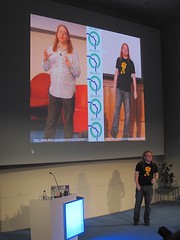I almost didn’t hear about Adobe’s on Air conference until it was upon us and the list of attendees was full. Luckily I got hold of one of the organizers and got a ticket that way (thanks Mike !).
I have to admit that I was dreading the whole thing to be a terrible marketing-driven show and tell of out-of-the-box solutions that solve every problem web development throws at you. This was my experience with a lot of large product company shows in the past – I was proven wrong.
The onAir tour was a great experience, both in terms of organization and content. For a whole day (doors opening at 9.15am and the event closing at 6pm) several speakers told us all about Air – from low level command line building via using different IDEs all the way to deployment, automated update and security of your applications.
The schedule was very tight with a few breaks in between and a larger lunch break. There was no feeling of boredom ever as all speakers kept their presentations snappy and hands-on. If you got in a lull, the rock-steady wireless could keep you busy (although I realized that live-twittering what is going on angers folk though).
People already versed in the “Flash/Flex scene” that came to the conference said that for them a lot was not news, but I think the idea of the onAir tour was not to preach to the Flash crowd but to expand the developer community for the product. Talking to several “Adobe virgins” I got the impression they met their goal. Sam Clark for example told me he came with very low expectations but very strongly considers getting into Air development now.
Of course all of this is post-show enthusiasm, but there are a lot of things Air does that really makes it interesting for web developers:
- you can use the technologies you are already using (HTML/CSS/JS)
- you don’t have to worry about cross-browser and cross-platform incompatibilities (you work with WebKit, which also gives you alpha transparency, rounded corners and all the other CSS goodies we so crave to have cross-browser)
- as a JavaScript developer you have reach you never had before – you can access the file system, create and access SQLite Databases or access 10MB of encrypted storage for your application (I remember messing around with .hta and COM objects to do this in JS once, not fun)
- You have full access to the native windows and menus of the operating system, thus being able to write applications that look and feel exactly like any other the user is already familiar with.
- The security model is much more sophisticated than what we have to deal with in JavaScript and browsers. That said, the option to be able to re-assign file associations for your application does sound potentially dangerous.
Of course not all is rosy about Air and the only presentation that showed the issues when implementing it on a large scale was the one by the BBC.
- Air applications need to be installed, which is something that does spook out users paranoid about viruses. Ironically this is the only way to keep them secure – but it is a hurdle. The web installer badges are a nice way to ease this process.
- The accessibility support is bad, this needs to get fixed, starting with proper keyboard support
- Air applications seem to take up a lot of RAM when they run for a long time. According to Jonathan Snook this is largely caused by the library that creates growl windows and once this is fixed we’ll have less problems.
- The installer is only available in English and needs to be i18n ready.
It is very interesting to see how all the web technologies seem to merge sooner or later with the common denominator being JavaScript. Seeing what Flash developers do with almost the same language I’ve used for years but unhindered by browser restrictions is pretty interesting and looks like a good challenge to marry the best practice quality ideas we found in the hostile browser world with this “let’s try if we can do it” attitude.
I also very much like the fact that Adobe promised to release all the presentation videos on their site after the road show and that they even provide an API to access all the media accumulated during the ride.
Of course there was schwag to go, in this case T-shirts and some goodies that were given out using raffle tickets. There was a tad of an embarrassing moment when I won twice, once with my own ticket and secondly with Steve Webster’s (who had to finish a project and couldn’t come). Hence I drew another winner and gave my prize away.
Good job, I am looking forward to the next event.
